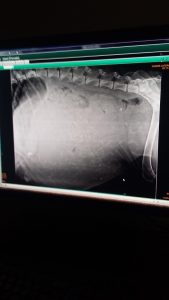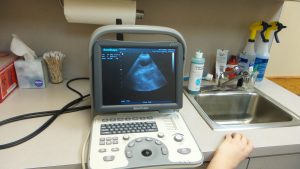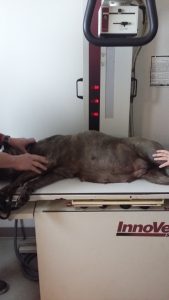Frequently Asked Questions
Question 1 : What exactly is a Traditional Cane Corso and what is the Outlaw Bloodline?
Answer : When I use the term “Traditional” I’m referring to what the Cane Corso was originally bred for and the temperament traits that were expected of it and deemed to be the standard. During the 1980’s The Cane Corso breed was near extinction and had to be revived. It was determined at the time of recovery by the S.A.C.C. that the Cane Corso above all else should always remain a dog that displayed great courage, high intelligence level and show a great since of loyalty. So a Traditional Cane Corso is one that has been selectively bred for those specific traits above all else.
What is a Bloodline? A Bloodline is established when a breeder has selectively bred a specific group of dogs within a breed for at least 3 generations. A Bloodline is not established simply because a dog comes from a certain Kennel. If a breeder ever wishes to establish a bloodline they must use the selective breeding process. Which is the exact breeding process used by the S.A.C.C. during the recovery of this breed.
So when you hear that the Outlaw Bloodline is an established line of the Traditional Cane Corso. It means that I specifically look for the temperament traits that were determined to be of the upmost importance by the S.A.C.C and then I use the same breeding process to reproduce those traits in future litters.
Our goal has always been to produce the best Traditional Cane Corso anywhere.
Question 2 : What’s the best way to reach us?
We try to answer questions on Facebook and Instagram but sometimes it’s easy to miss something. If you have any direct questions the best way to contact us is email. weberjcarl@gmail.com
Question 3 : How do I purchase a puppy?
Answer: Just fill out the contact us submission form. You will then receive notifications about available puppies and upcoming breeding’s etc. We sell our puppies via our VIP waiting list and on a first come first serve basis to those on our contact list (if they are not chosen by those on the VIP waiting list). There is no obligation whatsoever to be placed on the general contact list though that’s the best way to keep up to date.
Also be sure to follow us on face book to stay up to date year round, I tend to post there a lot more often with more of the daily activities and general pics. Also on Instagram #outlaw_canecorso
For any further questions feel free to contact us!
Question 4 : Do you “health test”
Sometimes there is much debate about “health testing “ on social media, usually amongst more novice breeders and enthusiasts.
Many Corso enthusiasts misuse the term “health testing”. Medically speaking there are 100’s of different types of health test. They generally fall under the categories of “causative”, “preventative” and “diagnostic”.
So technically speaking ALL of our dogs (both adult and puppies) are health tested frequently for a variety of reasons. We spare no expense when it comes to health of our dogs! But we DO NOT use the OFA protocol as one of our test.
Some breeders like to spread the word on the internet that if anyone doesn’t use the OFA protocol they don’t “health test” and are some how unethical breeders. Nothing could be further from the truth. The OFA protocol is designed to help prevent the future occurrence (genetic component only) of hip dysplasia. Hip dysplasia is one out of hundreds of possible genetic issues. Some lead people to believe that if you purchase a puppy from someone that does use this protocol you will receive a healthier dog. In fact just the opposite could be true. Why? Because the vast majority of these breeders are using the protocol incorrectly leaving their buyers with a very false sense of security. They are actually breeding some dogs that should never be bred. This could be one of the reasons why the health of the modern Corso seems to be getting worse instead of better. Any breeder not using this protocol correctly and leading their customers to believe they are, “could” and “should“ be held as liable. This is akin to “malpractice” in human healthcare. (For a detailed explanation about hip dysplasia and the correct use of the OFA protocol see article below. Including links to the OFFA and Canine Institute of Biology.)
According to Dr. Paolo Breber, biologist and world’s leading authority on the Cane Corso, the modern Cane Corso has many more health issues as compared to the older more traditional version of the breed.
The OFA protocol while great in theory falls very short in terms of practical use for most all breeders. It has been around since the 1960’s and has yet to cure hip dysplasia in any breed so far. I have never seen any study where it has proven to cause a significant reduction within a breed. This is because most breeders are unable to obtain the necessary vertical pedigree within the bloodline for it to be of effective use. The vertical pedigree IS NOT just test results of the dogs they own.
ONE of the things we use for disease control within our bloodline is genetic manipulation via the selective breeding process. This is a very powerful method available to breeders with the knowledge to line breed. Not only is this the preferred method for various breeders within many breeds. It has already been used with great success within the Cane Corso breed. It was successfully used during the recovery of the CC breed to treat a widespread hip dysplasia issue. Again this has been well documented and it’s evidence can be found in different books from Italy.
We sell dogs to many professional dog people including a few veterinarians, most of which understand the process and agree wholeheartedly.
Side note:
Different groups of breeders tend to use different methods of disease prevention and control for the dogs they breed. They tend to fall into 3 different groups.
1. Unethical puppy sellers and scammers. This group does absolutely nothing for any type of disease control. Greed is usually the motivation for breeding dogs. Usually found on places like Craigslist etc.
2. Hobby breeders, this group is usually the “self proclaimed” experts of breeders. They are definitely the loudest on the internet. They often participate in the show ring and feel this gives them justification for their opinions. Even if breeds like the Corso are a “working” breed and not a “show breed”. Hobby breeders generally do much more harm than good for “working” and “hunting” breeds.
3. Professional breeders, when I use the term “professional “ or “true” breeders I’m not trying to put any other group down. I’m simply referring to the breeders with the actual ability to manipulate the genetics of a dog one way or the other on purpose. These are the breeders that are responsible for developing new breeds or improving existing breeds by working specific blood lines within existing breeds. This group is usually much quieter and more professional on the internet allowing their dogs to speak for themself. Many in this group prefer to use genetic manipulation for disease control. Simply because they find it the most effective method. Some professional breeders do participate in pass time events like the show ring especially if they are working with breeds designed for that purpose.
*ALSO THERE ALWAYS HAS BEEN AND ALWAYS WILL BE CONFLICT AND FIGHTING BETWEEN “SHOW RING” AND “WORKING “ DOG BREEDERS. ESPECIALLY WHEN WORKING OR HUNTING BREEDS ARE INVOLVED.
HIP DYSPLASIA AND THE OFA PROTOCOL
Hip dysplasia is the medical term for a hip socket that doesn’t fully cover the ball portion of the upper thighbone. This allows the hip joint to become partially or completely dislocated.
The exact causes are still not fully understood by scientists at this time. But they have determined that it can be caused by either environmental or genetic factors. The environmental factors that can cause hip dysplasia pertain to things like a dogs weight, nutrition , amount of exercise, the surface on which the dog is raised etc. But there is a genetic component that can cause hip dysplasia as well. It’s the exact genetic component that’s still not fully understood by scientists. It may be a single gene or some combination of genes.
The genetic causes are not as high as some people think. Many tests show the dogs genetics are only responsible for 15%-40% of hip dysplasia. So a great many cases of this disorder are environmental.
When using the OFA screening protocol. A breeder uses an X-ray in combination with an examination of the dogs history (blood line) to determine
If a certain dog may have genetic predisposition to hip dysplasia.
When the OFA scores a hip X-ray they are judging the laxity (looseness) of the hip for one particular dog. Joint Laxity is the determining factor that predisposes a dog to the development of hip dysplasia. Excessive laxity could be the result of traumatic injury, overloading of the joint by weight, lack of muscle strength, or adductor forces (e.g., bringing the legs together). But it could also be caused by a dogs genetics.
After a breeder receives an X-ray result that shows a poor score they then look at the test results of the of the parents grandparents and their offspring (the vertical pedigree) of the dog to see if there is a constant pattern of results that might help determine if they are dealing with a genetic component vs an environmental one for the dog affected.
The OFA test score only determines the laxity (looseness) of the hip. It is the breeders responsibility to determine if it’s caused by an environmental or genetic factor. The only way a breeder can determine if it is environmental vs. genetic is to compare it to the testing results of the parents, grand parents and their offspring (the vertical pedigree). There must be a substantial database to compare the OFA score to that allows the breeder to look for patterns of consistency that can help in this determination one way or the other. If there is a pattern of poor results in the vertical pedigree that would be a good indication of genetic components.
Ok here is where it gets tricky Lol. If your a breeder that has a dog with a fair – poor OFA score, that dog may still be a good breeding candidate. How is this? Ok say you have a dog that has a poor OFA score but upon the examination of the dogs vertical pedigree (parents, grandparents and all siblings) you see there is no evidence of hip dysplasia or poor scores whatsoever. Then chances are the dog in question suffers from an environmental cause of possible hip dysplasia not a genetic one at all. This means the cause (environmental) of his poor score and possibility of hip dysplasia will not be passed on to further generations. The vice versa is also true. If you’re a breeder that has a dog with a good OFA score but upon examination of the vertical pedigree there is a strong pattern of hip dysplasia and poor scores that dog will still not be a good breeding candidate simply because the chance of genetic issues are still strongly present.
Also keep in mind that poor laxity of the joint may present itself at different ages of a dogs life, not just when the dog is scored.
My point to all of the above is that the vertical pedigree is the vital part of the OFA protocol! It’s the basis upon which all decisions are made. Without it accurate assessments cannot be made one way or the other. The vertical pedigree must contain testing results from all the parents, grandparents and the siblings produced .
Now for the elephant in the room…..How to get the vertical pedigree necessary for any type of assessment?
This is where the OFA protocol falls short in terms of practical use. The problem is that breeders simply do not have the testing results of the dogs needed in the vertical pedigree for it to work. Many breeders have tried to develop the needed data base for the OFA protocol to work. The problem is that the breeder needs the puppies sold from the litters to be tested at 2 years old and the results sent to the breeder so they can develop the needed database. The vast majority of people that purchase puppies would not follow through with this. There have been breeders that have tried diligently to offer various types of incentive programs etc. for new puppy owners to follow through with in hopes of increasing customer compliance.
But actual customer compliance still turns out very poor in most cases.
So if a breeder ever claims to use the OFA protocol and has the test results of their dogs ALWAYS ask to see evidence of the vertical pedigree they used to base their breeding decisions on. If they don’t know what your talking about or do not have any such database you can be rest assured the results will in no way be accurate.
The Cane Corso is a newer breed to the United States and many novice breeders though well intentioned do not understand how this protocol works. While there are other more experienced breeders that know exactly how it works and claim to “Health Test” their dogs. But could care less about actually doing it in a way that may be of any actual benefit to the breed whatsoever. Sadly for some breeders greed is the motivating factor.
Some breeders may be tempted to adopt the ” well something is better than nothing ” approach. As you see it’s not! It will only lead to the breeding of dogs that shouldn’t be bred.
According to the Canine Institute of Biology : “Researchers have been working hard for decades looking for solutions, and breeders have been doing their best to reduce the risk of producing affected puppies. But still the problem remains.” “Genetic selection should continue to produce modest progress in the reduction of hip dysplasia”
This is something many breeders have know for years. This is why we use selective breeding and genetic manipulation in attempts to rid our bloodline of any unwanted diseases. It’s a powerful method that’s time tested and effective.
In fact during the reconstruction process of the Cane Corso breed there was a serious problem with hip dysplasia in which the selective breeding process was used to bring it down to a very acceptable level.
www.offa.org The OFA testing protocol
The Institute of Canine Biology: The 10 most important things to know about hip dysplasia
- We work very closely with our vet. In attempts to obtain optimal health for the Outlaw Bloodline




